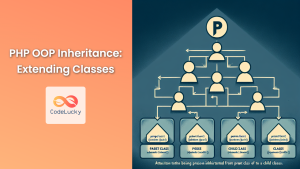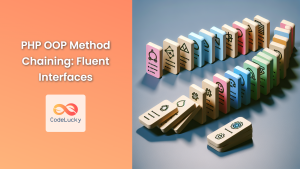In the world of Object-Oriented Programming (OOP), code reusability is a crucial concept that helps developers write cleaner, more efficient, and maintainable code. PHP, being a versatile language, offers various ways to achieve this goal. One such powerful feature is Traits, introduced in PHP 5.4.0. Traits provide a mechanism to reuse methods in multiple independent classes, solving the limitations of single inheritance in PHP. Let's dive deep into the world of PHP Traits and explore how they can revolutionize your coding practices! 🚀
Understanding Traits in PHP
Traits are a group of methods that you can include within another class. They allow you to reuse code without relying on inheritance, thus avoiding the complexities that can arise from PHP's single inheritance limitation. Think of Traits as a "copy and paste" mechanism at the language level, but with a much more elegant and maintainable approach.
🔑 Key Points about Traits:
- Traits are declared using the
traitkeyword. - They can contain methods and properties.
- Traits cannot be instantiated on their own.
- Multiple traits can be used in a single class.
- Traits can use other traits.
Let's start with a simple example to illustrate how traits work:
trait Loggable {
public function log($message) {
echo date('Y-m-d H:i:s') . ": $message\n";
}
}
class User {
use Loggable;
public function login() {
// Login logic here
$this->log("User logged in");
}
}
class Product {
use Loggable;
public function purchase() {
// Purchase logic here
$this->log("Product purchased");
}
}
$user = new User();
$user->login();
$product = new Product();
$product->purchase();
In this example, we've defined a Loggable trait with a log method. Both the User and Product classes use this trait, allowing them to utilize the log method without inheritance. When we run this code, we'll see output similar to:
2023-06-15 14:30:45: User logged in
2023-06-15 14:30:45: Product purchased
This demonstrates how traits enable code reuse across unrelated classes, promoting a more flexible and modular design.
Advanced Trait Techniques
Now that we've covered the basics, let's explore some more advanced techniques and features of PHP Traits.
1. Using Multiple Traits
PHP allows a class to use multiple traits, which is particularly useful when you need to combine functionalities from different sources. Here's how you can use multiple traits in a single class:
trait Loggable {
public function log($message) {
echo date('Y-m-d H:i:s') . ": $message\n";
}
}
trait Serializable {
public function serialize() {
return serialize($this);
}
public function unserialize($data) {
$this = unserialize($data);
}
}
class User {
use Loggable, Serializable;
private $username;
public function __construct($username) {
$this->username = $username;
}
public function getUsername() {
return $this->username;
}
}
$user = new User("john_doe");
$user->log("User created");
$serialized = $user->serialize();
$newUser = new User("temp");
$newUser->unserialize($serialized);
echo $newUser->getUsername(); // Outputs: john_doe
In this example, the User class uses both the Loggable and Serializable traits, inheriting methods from both.
2. Resolving Naming Conflicts
When using multiple traits, you might encounter naming conflicts if two traits define methods with the same name. PHP provides a way to resolve these conflicts using the insteadof and as keywords.
trait A {
public function smallTalk() {
echo "Trait A small talk\n";
}
public function bigTalk() {
echo "Trait A big talk\n";
}
}
trait B {
public function smallTalk() {
echo "Trait B small talk\n";
}
public function bigTalk() {
echo "Trait B big talk\n";
}
}
class Talker {
use A, B {
B::smallTalk insteadof A;
A::bigTalk insteadof B;
B::bigTalk as talk;
}
}
$talker = new Talker();
$talker->smallTalk(); // Outputs: Trait B small talk
$talker->bigTalk(); // Outputs: Trait A big talk
$talker->talk(); // Outputs: Trait B big talk
In this example, we resolve the conflict by specifying which trait's method to use with insteadof. We also use as to create an alias for B::bigTalk.
3. Changing Method Visibility
Traits also allow you to change the visibility of the methods they provide. This can be useful when you want to use a trait's method internally but don't want to expose it as part of the class's public interface.
trait Loggable {
public function log($message) {
echo date('Y-m-d H:i:s') . ": $message\n";
}
}
class User {
use Loggable {
log as private;
}
public function login() {
$this->log("User logged in");
echo "Login successful\n";
}
}
$user = new User();
$user->login(); // Works fine
// $user->log("This will cause an error"); // This would cause an error if uncommented
In this example, we've changed the visibility of the log method to private when using it in the User class.
4. Abstract Trait Methods
Traits can also define abstract methods, which must be implemented by the classes using the trait. This is useful when a trait requires certain methods to be present in the using class.
trait Loggable {
abstract public function getLogName();
public function log($message) {
$name = $this->getLogName();
echo date('Y-m-d H:i:s') . " [$name]: $message\n";
}
}
class User {
use Loggable;
private $username;
public function __construct($username) {
$this->username = $username;
}
public function getLogName() {
return $this->username;
}
public function login() {
$this->log("Logged in");
}
}
$user = new User("john_doe");
$user->login(); // Outputs: 2023-06-15 15:30:45 [john_doe]: Logged in
In this example, the Loggable trait defines an abstract getLogName method, which the User class must implement.
Best Practices and Considerations
While traits are powerful, they should be used judiciously. Here are some best practices and things to consider:
-
Single Responsibility: Keep traits focused on a single responsibility or functionality. This makes them more reusable and easier to maintain.
-
Avoid Overuse: While traits can solve many problems, overusing them can lead to complex and hard-to-understand code. Use them when they genuinely improve your code structure.
-
Documentation: Always document your traits well, especially if they're intended for use across multiple projects or by other developers.
-
Naming Conventions: Use clear, descriptive names for your traits. A common convention is to use adjectives (e.g.,
Loggable,Serializable) or nouns describing their functionality (e.g.,Logger,Serializer). -
Composition vs Traits: Consider whether composition (using objects as properties) might be a better solution for your specific use case. Traits are great for mixing in behavior, but sometimes having separate objects is clearer.
Conclusion
PHP Traits offer a powerful way to reuse code across classes, solving the limitations of single inheritance and promoting more flexible, modular designs. By allowing methods to be shared between independent classes, traits enable developers to write DRY (Don't Repeat Yourself) code more effectively.
We've explored the basics of creating and using traits, advanced techniques like resolving naming conflicts and changing method visibility, and best practices for incorporating traits into your PHP projects. Armed with this knowledge, you can now leverage the full power of traits to create more efficient, maintainable PHP applications.
Remember, like any programming feature, traits are a tool in your toolbox. Use them wisely, and they can significantly enhance your object-oriented PHP code. Happy coding! 💻🎉



















